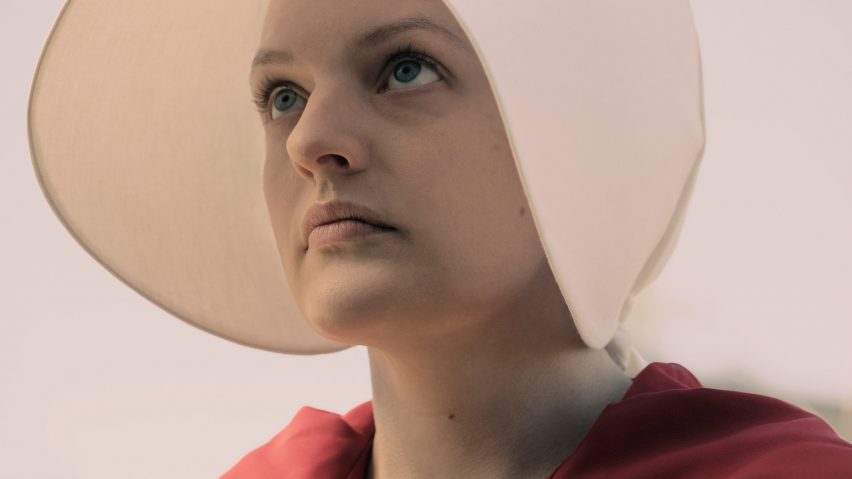
My costumes are part of a "quiet uprising" among women, says Handmaid's Tale designer
In an exclusive interview with Dezeen, costume designer Ane Crabtree talks about her work on dystopian TV show The Handmaid's Tale, and how the blood-red capes she created have become a symbol of protest among women.
As lead costume designer on the American TV series, Crabtree, 53, designed a range of visually striking garments. These have since been worn by women in protests all over the world.
"There is a quiet uprising that has been started," she said.
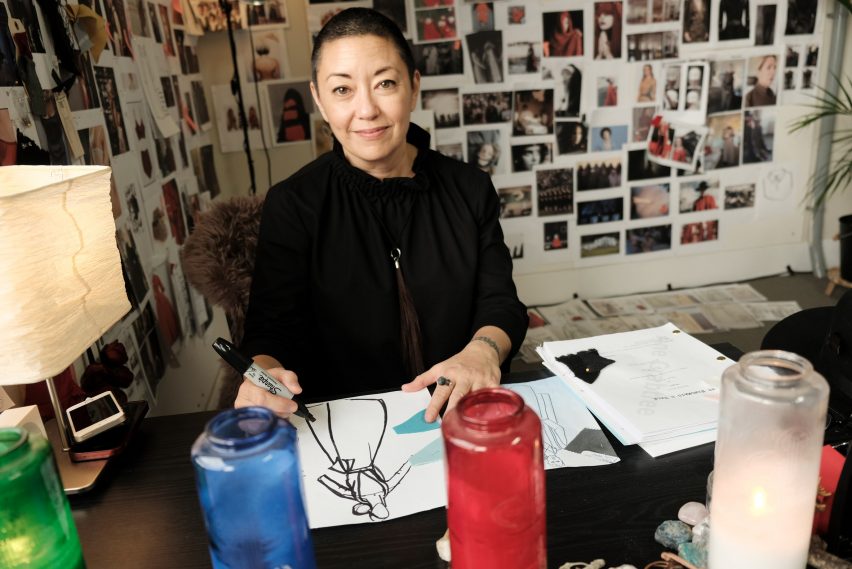
The Handmaid's Tale has rocketed into popular consciousness and been described as the "best thing you'll watch all year".
It is set in a near-future USA, in a time when fertility rates have collapsed. As a result, the few remaining fertile women are held captive by the new Gilead government as "handmaids" and forced to bear children for the ruling elite.
The handmaids are always dressed in red floor-length capes and dresses, and have to wear white bonnets when they leave their homes – similar to outfits that women wore a century ago.

Since the show premiered in May, activists in Ohio have worn the costumes while staging a protest against a bill placing more restrictions on abortion, and Polish women have donned the attire to show their contempt for President Trump's visit to their country.
"My jaw dropped open – it's jarring and emotional to see them use these costumes," Crabtree told Dezeen. "The thing that's so intensely poetic for me is that women are coming together and they're finding power in a uniform that was meant to hinder them and imprison them – that to me is the perfect outcome."
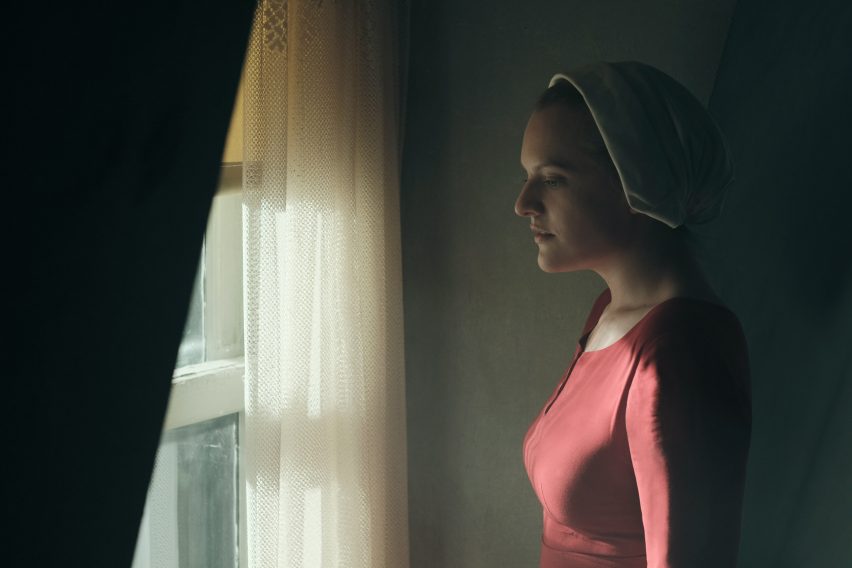
The TV series is based on a novel by Margaret Atwood published in 1985, and has been adapted and directed by a largely female creative team.
As per the book, Crabtree used colour to distinguish each character. Handmaids in red, commanders and "eyes" (undercover operatives) in black, commanders' wives in blue, "guardians" (security forces) in navy, "marthas" (servants) in green and "econowives" (lower-class wives) in grey.
But she was keen to put her own "dark and dystopian" spin on these shades, which would be reflective of the nature of the programme while also differentiating her work from that of its previous film adaptation.
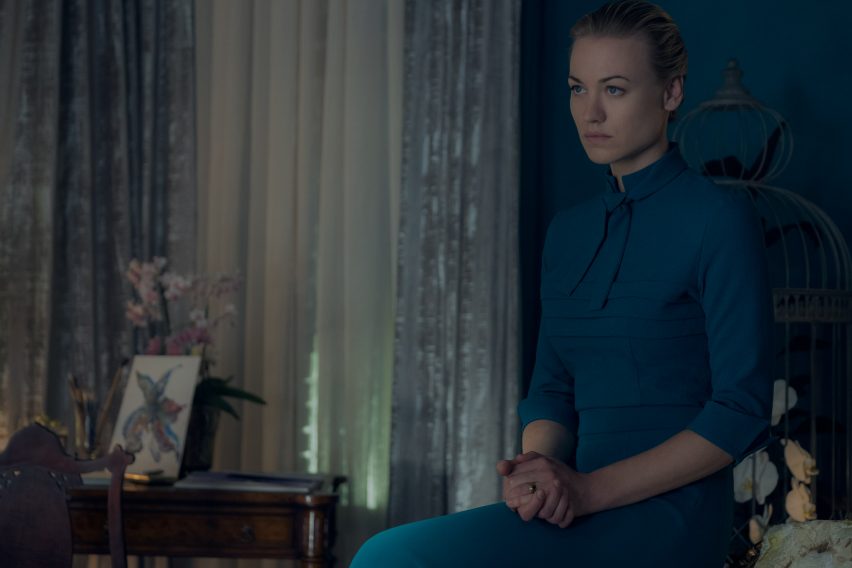
"We knew we couldn't do the primary red and blue, because it's distinctive of the 90s film," she said. "We tweaked the colour knowing what camera was going to be used, and that it was going to be a dark and dystopian world."
The show has gone on to be nominated for 13 Emmy awards, one of which is for Crabtree's costume design. Its successful reception has been attributed to its timeliness in terms of the current political climate.
At the time of filming The Handmaid's Tale, America was in the midst of the presidential election – which eventually saw Donald Trump become the country's 45th president.
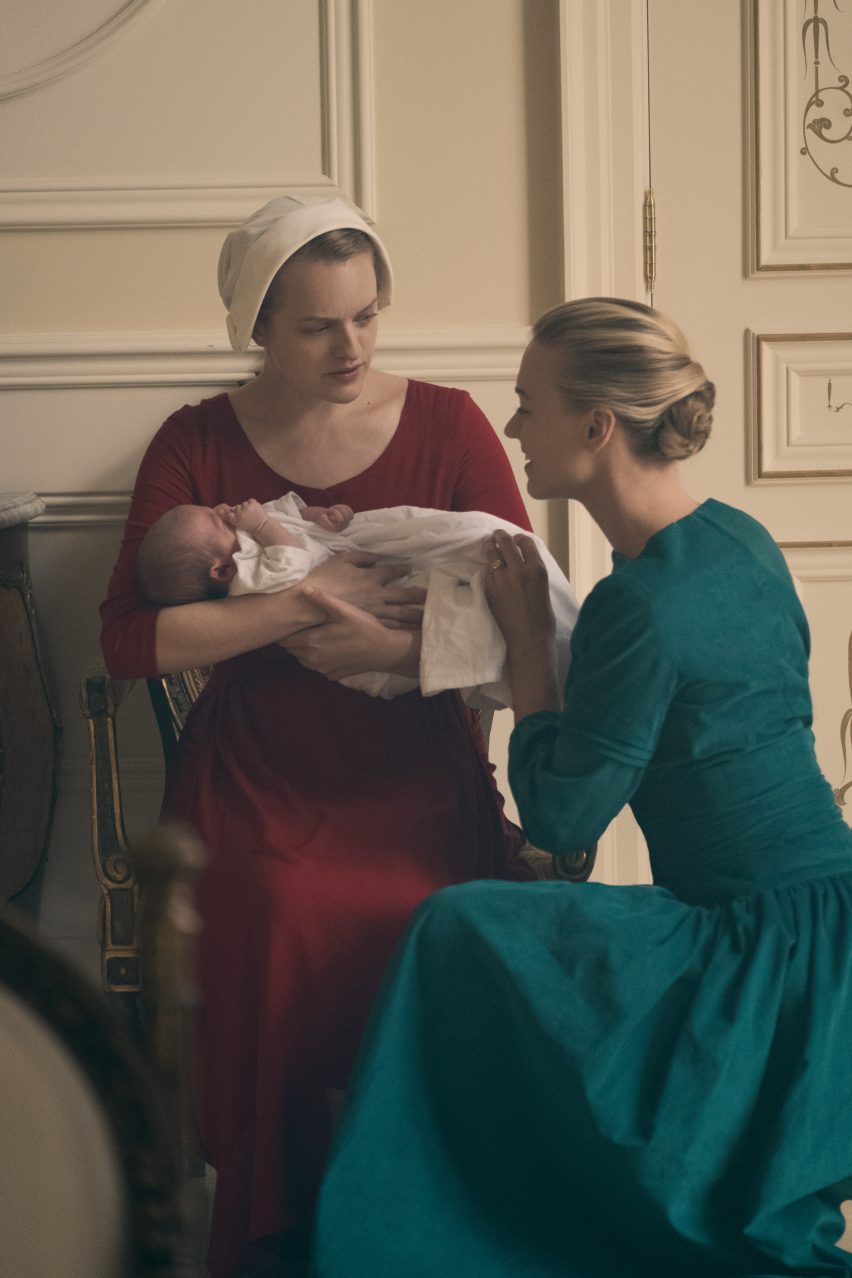
Crabtree says the turn of events, inevitably, affected her process – particularly when the scripts began to mirror what was happening in the real world.
"[We began filming] two months before our new Gilead commander got elected in the US, so by November my own design mind had started to shift – the event fuelled me," she said. "The alignment between the script and what was happening in real life was incredible."
Crabtree spoke to Dezeen ahead of the filming of the second season of The Handmaid's Tale. The designer was born in Kentucky to Japanese immigrant parents, and lived in housing projects until she moved to the UK to study Shakespeare and art at Harlaxton College.
She worked in fashion for a number of years before moving into film in the late 80s – her first project being on a music video by Oscar-nominated Macedonian director Milcho Manchevski.

Since then, Crabtree has designed costumes for shows including Masters of Sex, The Sopranos and Westworld, and is now directing her own documentary and short film.
Read an edited version of the transcript from our interview with Ane Crabtree below.
Alice Morby: How did you get on board with The Handmaid's Tale?
Ane Crabtree: I read the book years ago and I'd seen the film when it first came out in 1990 – I remember being haunted by it. My agent said they were making a series about this, and I met with Bruce Miller, the show's creator, and Warren Littlefield – the executive producer.
Bruce had seen my work on Masters of Sex. He said he knew the costumes were going to be a big deal with Handmaid's Tale, and he wanted someone who knew how to make things from scratch to create something new.
It was exciting that he was so into the costumes, and also that he really wanted something new, as there's been so many versions of the story. Because of this, I knew that I wouldn't want to replicate history of what had gone down before.
I read the book years ago and I'd seen the film when it first came out in 1990 – I remember being haunted by it.
I was also drawn to the project due to the fact that Elizabeth Moss was the lead. When Top of The Lake came out, I watched all of that – I'd never seen Lizzie in anything before it, although she's been around forever. I remember thinking that she is really something special.
Alice Morby: What references did you draw on for your designs?
Ane Crabtree: It was really all over the place. I did dive into the book for old time's sake and looked at images from the film, but I stopped immediately because I realised that it was a very specific visual take.
In the book, it's about not having any money and not having the usual things that we're accustomed to. I tried to come at that from a place of reality. The folks of Gilead aren't going to have a lot of clothing. They're going to have pieces they can work in, get cleaned and wear every day. They'd have two outfits maximum.
I then started looking at imagery from the 1900s and the 1990s. I remember the 90s being a moment when we were saying it was "the future", and wondering what that would look like. I looked to many cultures where people dress the same, as well as uniforms throughout time.
Joseph Fiennes' commander character is someone who is full of idealism and ideology, and I think that kind of person in his inner-self is quite like Hitler. There's this idealistic eye, a nationalistic eye – all of that went into this in terms of design.
Overall, I knew that I didn't want this show to look dated five years from now, so I wanted everything to be quite classic.
Alice Morby: Can you tell me about your use of colour?
Ane Crabtree: The roots of the colour are in the book itself. The handmaids are in red, the commanders' wives are in blue, and so on. We tweaked the colour knowing what camera was going to be used, and that it was going to be a dark and dystopian world.
We knew we couldn't do the primary red and blue, because it's distinctive of the 90s film. Reed Morano, the director, has a brilliant cinematography background and she felt that there's something quite beautiful in 50s Technicolour films. The 50s period also spoke to us in terms of the conservatism of the time, so we looked further into that.
Having spent time talking about the Technicolour thing, Reed suggested going to darker – so it'd be Technicolour but more moody. I like deeper colours, I think they look more poignant and dark and dystopian.
Reed showed me a photo of very dark maple leaves, and then the sky beyond it was quite dark and teal. She said this is it, this is like the handmaids and wives. We started with those two colours, but we also wanted to make sure it was realistic, so that's where the different tones came in. There's more tonal variation in the commanders' wives, because they can afford to have different tailors.
Alice Morby: How did you choose the colours?
In the book, marthas were always in green. I found a photo of a moth that's a fading green colour, and that to me felt very much like the marthas. It's not what one would consider to be a beautiful intense colour, but it fades in with the environment – which is the idea for the marthas, fading in to the household so that they don't stand out. They're a support system; they're basically a servant.
I used black for the commanders and the eyes, which came from the book. I wanted a non-colour that was all-powerful, and would absorb all the other colours – the darkest and most foreboding thing in the frame.
Beyond that it was a military approach. The guardians underneath them are in navy, as they're the ones who are less of the mental muscle like the eyes, but more of the physical muscle.
In a military way, the aunts are this brownish colour that came from British WWI uniforms.
The colour only colour I made up was the econowives – they're in grey. But in the book they're portrayed to be multicoloured strips. The colour went with the greyness of Gilead too.
The alignment between the script and what was happening in real life was incredible
There's pink for the little girls, for Hannah, you see the pink cape. It's a byproduct and faded version of the handmaids' red. The children would all be in red but with remnants of pinks and blues because it's conservative, but reflective of them being the children of handmaids.
In the end. I thought to myself, how did we do all that?! How did we get all that done. You cannot dissect all that you have to do, you just have to start jumping in order to not be overwhelmed by it.
Alice Morby: How do you feel about the costumes being used as a symbol of protest?
Ane Crabtree: I humbly admit that I was just hired to be a costume designer – and this has never happened in my career in this way, in an important political way.
We started making the costumes in July, I started sketching in May, and then we began shooting in September. So it was two months before our new Gilead Commander got elected in the US. By November, my own design mind started to shift – the event fuelled me. I returned home, and NARAL – a pro-choice charity – contacted me to ask for help because they wanted to protest in the senate.
My jaw dropped open; I was so humbled by their strength. I had to say I cannot do this for you, but I can suggest how to do this quickly. From that moment, every time there was a protest in the US, or more recently in Poland, it's jarring and emotional to see them use these costumes. The thing that's so intensely poetic for me is that women are coming together and they're finding power in a uniform that was meant to hinder them and imprison them – that to me is the perfect outcome.
Alice Morby: What was it like to be a woman working on this show?
Ane Crabtree: My memories of it were very fast. Unfortunately you can't appreciate all that's happening because the pace is so quick. After November [when the US election was held], myself, creator Bruce Miller, writer Eric Tuchman and actors Lizzie Moss and Yvonne Strahovski had a sitting. There were a few Americans on the show, and we were in this state of shock on the day that it happened. We came to work, and oddly the scripts were beginning to totally mirror what was happening day to day in the press. It was too much. It fuelled things, but it was really painful. I remember just crying.
I went into a barber shop near where we were filming, and I remember hearing all the people in there just bashing Americans for voting him in. I just kept my mouth shut – I didn't want them to know I was American, I was embarrassed.
Alice Morby: Do you think the political context is what pushed the show to becoming so successful?
Ane Crabtree: It's hard to say, it's a bit of a head scratcher, but we absolutely knew it was important. The alignment between the script and what's happening in real life is incredible.
Alice Morby: So how did you end up getting into costume design?
Ane Crabtree: I didn't have a classic journey into costume design. I was a kid from Henderson, Kentucky and grew up in the projects. I grabbed at any kind of art that came my way, because I had an inkling that I was okay at that. I didn't study theatre because I was too shy. I went to study Shakespeare and art at Harlaxton College in England during the punk era, so for a very quiet kid of an immigrant to go to school in England where there was more than one newspaper – my whole world opened up. I just aligned with the politics and the fashion of the time.
One of my teachers was Lady Wedgwood, she was so instrumental in getting me interested in art history. She was this eccentric woman who married a Wedgwood, but her big love was history. Then I went from there to FIT in New York, where I studied fashion, which was incredibly helpful for what I do.
I have felt that as a byproduct of this show, there is a quiet uprising that has been started
I started working in film in between 1989 and 1990. I didn't talk about my education, because it didn't apply. I wasn't a film student; I didn't do theatre at Harvard like the other costume design people. I felt like a fake to say I was a costume designer.
On my birthday, I was broke. I contacted Macedonian director Milcho Manchevski, who I still know to this day, and he gave me my first music video job. He then started doing this film with Joseph Fiennes, called Dust, and he asked me to do it.
But all of these experiences have been very instrumental in me being a costume designer. When I look at my work now, I see all of these moments come up. It doesn't matter that I didn't go to Harvard or Yale to study theatre – I still love theatre; it just didn't happen that way.
Alice Morby: In film, figures show that women make up a majority only in costume and wardrobe departments and casting. Why is this, do you think?
Ane Crabtree: I don't know – and I am the biggest tomboy on earth, and I always say don't call me one of the "vanities". It's country-wide, I think that women have been relegated to the jobs that others think are female. Of course it's changing really slowly.
I think it's because of history, and men being in power for as long as film and TV has been around. It's changing now, thank god, because certain people have big mouths and can open doors for others. I've been lucky to have a friend, Mimi Leder, who's a female director, and she was the first to graduate from AFI [American Film Institute].
Alice Morby: How do you think the industry will change in the next 10 years?
Ane Crabtree: In 10 years, I hope there is no diminution. I hope that there's good, smart people who happen to be of any sex. Women are powerful and formidable, and we're threatening for a lot of men – so I see why they've said, "oh no, you should be in make-up" or "you should be a mum, not working". But even in my lifetime, at 53, I've seen the role of men change. We've gone backwards in many ways recently, but I'm hopeful that I see a change in men or anyone that has the upperhand or the power.
In the US, white men have all the power. We're seeing it with the regime that's happening now, yet those facades crumble – it just takes time. With every step forward, like having a black president, there's always going to be a backlash. So you take a few steps back and then you try again, every time.
I have felt that as a by-product of this show, and of course it's fantasy – it's a TV show. But there is a quiet uprising that has been started, that I adore.
Photography by George Kraychyk, courtesy of Hulu.